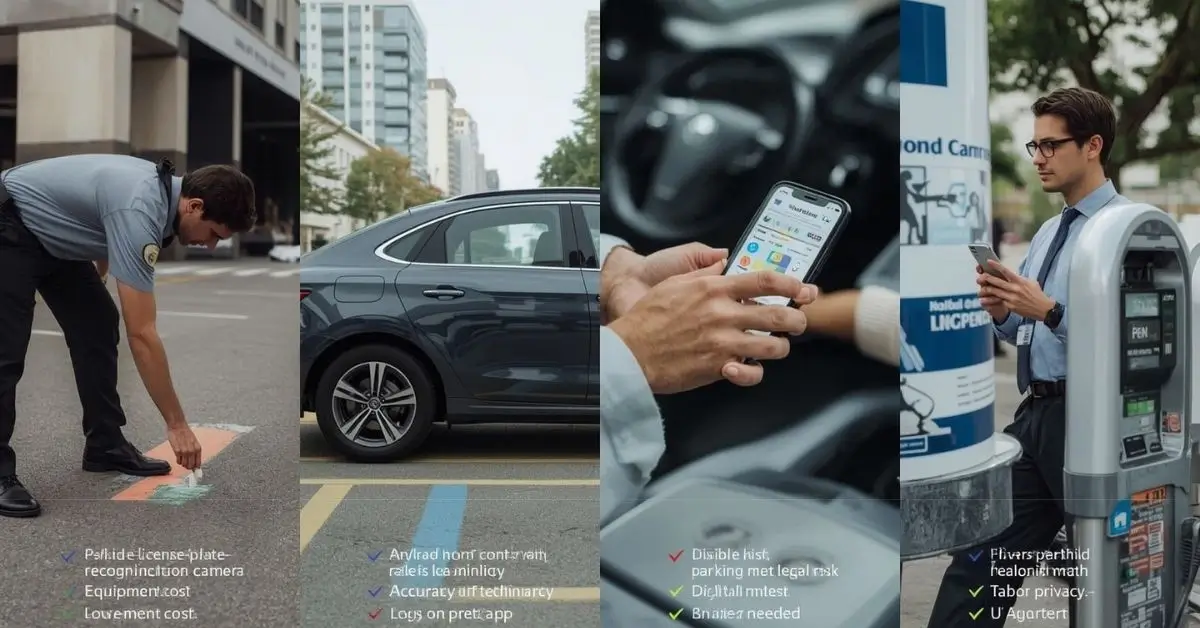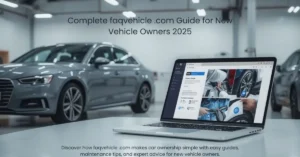Key Intake
Q1: What Does Chalk on Tires Do?
Chalk on tires tracks how long your vehicle stays parked.
Q2: What kind of chalk do parking officers use?
They use industrial chalk sticks or grease markers visible, weather-resistant, and removable.
Q3: Is tire chalking legal on private property?
Yes, if authorized by the property owner or HOA. The Fourth Amendment only limits government actions.
Q4: Can I contest a chalk-based ticket?
Absolutely. If you’re in a state under the Sixth Circuit or have timestamped proof of movement, you can challenge it.
Q5: Do all cities still use chalking?
No, many have shifted to license plate scanners or parking apps for faster, contactless enforcement.
Q6: How long does chalk last on a tire?
Usually 24-48 hours in dry weather, less if it rains or you drive frequently.
Table of Contents
What Does Chalk on Tires Do?
Chalk on tires tracks how long your vehicle stays parked.
Parking officers mark a tire, record the time, and later check if the mark has moved. If it hasn’t, they issue a citation. This low-cost method helps cities manage parking turnover and enforce time limits in busy areas.
Unlock More Insights
Introduction
What does chalk on tires do might sound like a small-town mystery, but it’s actually a long-standing parking enforcement tactic. You might notice a faint white line on your tire and wonder if it means a ticket, and it often does. That mark isn’t random. It’s part of a method called tire chalking, used for decades to track how long cars stay parked.
According to data from the International Parking & Mobility Institute, more than 60% of U.S. municipalities still use chalking as their primary enforcement tool. Yet a federal court split in rulings (Taylor v. Saginaw, 2019; Verdun v. San Diego, 2022) has thrown its legality into question.
In short, what does chalk on tires does is simple: it helps track parking duration, but its implications reach deep into privacy, property rights, and the evolving future of urban mobility.
Why Do Parking Enforcement Officers Chalk Tires?

Officers use chalking as a quick, low-tech way to measure parking duration. The mark on your tire helps them know if a vehicle has stayed longer than the posted limit.
Key purposes:
- Ensures parking turnover for businesses and residents.
- Provides visible evidence for issuing tickets.
- Keeps parking fair in areas without meters or sensors.
Truth is, chalking remains popular because it’s cheap, fast, and effective for small towns or cities with limited budgets.
If are new to this type of situation and are seeking more information onchalk tire then try watching:
→Tire Pressure 101: The Chalk Test
How Does Tire Chalking Work?
Tire chalking follows a predictable, step-by-step process that’s easy to overlook, until it results in a fine.
Here’s the typical enforcement flow:
- Officer marks the tire near the 6 o’clock position (bottom center).
- They log your car’s location, time, and sometimes snap a photo.
- After the posted time limit, they return to check the chalk mark’s position.
- If it hasn’t moved, a ticket is issued.
Common challenges:
- Rain or car movement can erase marks.
- Some drivers move slightly, trying to avoid a ticket, but officers often record valve stem positions to counter this trick.
Key Intake: Tire chalking is simple pattern-tracking for parking compliance.
Is Tire Chalking Legal?

The legality of what does chalk on tires do depends on where you live. U.S. federal courts are split.
The Circuit Split Explained:
- Sixth Circuit (MI, OH, KY, TN): In Taylor v. City of Saginaw (2019), the court ruled that chalking a tire without a warrant is a Fourth Amendment violation because it’s a form of physical trespass.
- Ninth Circuit (CA, WA, OR, AZ, NV): In Verdun v. San Diego (2022), the court decided chalking is not unconstitutional, instead, it’s an administrative search for public benefit.
- Other Circuits: No clear rulings yet, leaving local policies to decide.
What does this means?
Tire chalking might be illegal in Michigan but fully valid in California. Always check your city’s parking policy before contesting a ticket.
Does Tire Chalking Violate the Fourth Amendment?
In some jurisdictions, yes. The Sixth Circuit Court views chalking as a “search” under the Fourth Amendment since officers physically mark private property (your tire) to gather data.
However, other courts, especially in the Ninth Circuit argue it’s a minimal, non-invasive regulation, not a privacy violation.
Bottom line: There’s no national consensus. The outcome depends on which circuit you’re in and how your local government enforces parking laws.
What Are the Alternatives to Tire Chalking?

Cities are modernizing enforcement to avoid lawsuits and boost efficiency.
Comparison Table:
| Method | Equipment Cost | Accuracy | Legal Risk | Data Privacy | Labor Needed |
| Tire Chalking | Very Low | Moderate | High (in some states) | Minimal | High (manual) |
| License Plate Recognition (LPR) | High | Very High | Low | Moderate | Low |
| Mobile Parking Apps | Moderate | High | Low | High | Medium |
| Smart Meter Networks | Very High | Very High | Low | Moderate | Low |
Interpretation:
While tire chalking is the cheapest, digital enforcement tools are more reliable, scalable, and legally safer for cities, though they require upfront investment.
Can You Remove Chalk from Your Tire?
You can, but it won’t help much. Removing chalk doesn’t erase the enforcement record, since officers often document your valve stem position or take timestamped photos.
What to know?
- It’s not illegal to wash your tires.
- But removing chalk won’t stop a citation already recorded.
- Some jurisdictions could see deliberate removal as tampering (rarely enforced).
Better strategy: move your car beyond the posted time limit or one full block away.
What Should I Do If My Tire Is Chalked?

Seeing chalk on your tire? Don’t panic. Just follow a quick process before the clock runs out.
5-Minute Chalk Response Checklist
- Photograph the chalk mark, valve stem, and nearby signage.
- Note the time you discovered the mark.
- Move your vehicle before the posted time expires.
- Record your new location or a timestamped receipt.
- If cited, appeal with your documented proof.
Truth is, early documentation is your strongest legal defense.
Myth vs. Fact: Common Tire Chalking Misconceptions
Confusion about what does chalk on tires do has led to viral myths online. Let’s separate fiction from fact.
| Myth | Fact | Source |
| Chalk marks on tires are a form of vandalism. | Legally, chalking by parking enforcement is not considered vandalism because the chalk is temporary and does not cause damage to the tire. | Quora |
| Tire chalking is illegal everywhere in the U.S. | The legality of tire chalking varies by jurisdiction due to conflicting federal court rulings. It has been deemed unconstitutional in some circuits but permissible in others. | University of Cincinnati Law Review, Civica Law Group |
| Chalking is the only way to enforce timed parking. | Numerous alternatives exist and are being adopted, including “E-chalk” (photographing the tire and valve stem position) and, more commonly, Automatic License Plate Recognition (LPR) systems. | OperationsCommander, CT Insider, Dayton Daily News |
| Wiping the chalk off your tire will always prevent a ticket. | While this might work if an officer doesn’t notice, some enforcement methods now combine chalking with license plate reader software, creating a digital record of the vehicle’s presence. | CT Insider |
| Chalk on tires is always from parking enforcement. | While less common, sometimes people will use a “chalk test” to check their tire pressure. Also, in some instances, it could be a prank or an attempt by a neighbor to intimidate a driver. | WikiHow, Reddit |
Sources
The information and analysis in this article is draw from authoritative industry, legal, and academic references that have examined the practice and legality of tire chalking in depth:
- Gtechna: “Digital Tire Chalking: How LPR Can Boost Parking Enforcement”, offers insights into how municipalities are modernizing enforcement with digital tools.
- Civica Law Group: “Chalked Wheels and Constitutional Debates”, explores the Fourth Amendment debates tied to traditional chalking methods.
- Syracuse University College of Law: Analyzes how the Ninth Circuit justified chalking under the “reasonableness” clause of the Fourth Amendment.
- Berman, Berman, Berman, Schneider & Lowary LLP: Provides case commentary asserting tire chalking as a potential rights violation under recent federal interpretations.
- Operations Commander: Discusses emerging alternatives like automated license plate recognition to replace manual chalking for compliance accuracy.
Author Bio
Evan R. Miles is an Urban Mobility Policy Analyst with an experience of 10 years of field research in municipal enforcement systems. Evan decodes local transportation laws and parking regulations to help urban commuters, businesses, and civic planners make smarter mobility choices.












